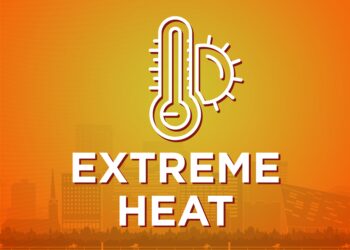Objective: To ensure the safety and well-being of staff and patients during extreme heat weather conditions through proactive planning, immediate response measures, and ongoing monitoring.
Key Points
Preparation
- Emergency Plan
- Review and update the office’s emergency plan to include specific protocols for extreme heat.
- Ensure all staff are familiar with the emergency plan and conduct regular drills.
- Communication
- Establish a clear communication plan to inform staff and patients about heat-related precautions and updates.
- Use multiple channels (emails, SMS, office intercom, posters) to disseminate information.
- HVAC System Maintenance
- Regularly service the heating, ventilation, and air conditioning (HVAC) system to ensure it functions optimally.
- Install and maintain backup cooling systems in case of HVAC failure.
- Hydration Stations
- Set up hydration stations with water, electrolyte drinks, and cooling towels throughout the office.
- Encourage staff and patients to stay hydrated.
Immediate Response
- Temperature Monitoring
- Monitor indoor temperatures closely, ensuring they remain within a safe range (ideally below 75°F/24°C).
- Use thermometers or smart thermostats to track temperature changes.
- Adjust Office Hours
- Consider modifying office hours to avoid the hottest parts of the day, typically between 12 PM and 4 PM.
- Allow for flexible work hours or remote work for staff where possible.
- Patient Appointments
- Prioritize appointments based on medical necessity and reschedule non-urgent visits if extreme heat conditions are severe.
- Offer telehealth options to reduce the need for patients to travel in extreme heat.
- First Aid and Medical Supplies
- Ensure supplies for heat-related illnesses, such as cold packs and rehydration solutions.
- Train staff to recognize and respond to signs of heat exhaustion and heat stroke.
Ongoing Monitoring and Support
- Heat Illness Training
- Provide training for staff on the symptoms of heat-related illnesses and appropriate first aid measures.
- Ensure staff know how to use any additional equipment, such as cooling vests or fans.
- Patient Screening
- Screen patients for signs of heat-related stress upon arrival and provide immediate care if necessary.
- Pay special attention to high-risk groups, such as the elderly, young children, and those with chronic illnesses.
- Environment Adjustments
- Keep blinds or curtains closed to block direct sunlight.
- Use fans and portable air conditioning units to enhance air circulation.
- Rest Breaks for Staff
- Implement mandatory rest breaks for staff to cool down and rehydrate.
- Provide a designated cool area where staff can rest.
Communication with External Agencies
- Coordination with Health Departments
- Stay in regular contact with local health departments for updates and guidance on extreme heat conditions.
- Follow public health advisories and recommendations.
- Emergency Services
- Have contact information for local emergency services readily available.
- Know the protocols for transporting patients or staff to emergency facilities if necessary.
Documentation and Feedback
- Incident Reporting
- Document any heat-related incidents, including symptoms, actions taken, and outcomes.
- Use this data to improve future responses and update emergency protocols.
- Feedback Mechanism
- Establish a system for staff and patients to provide feedback on heat emergency measures.
- Use feedback to refine and enhance safety protocols.
Conclusion
By implementing these measures, the medical office can significantly reduce the risk of heat-related illnesses and ensure a safe environment for both staff and patients during extreme heat weather emergencies. Regular reviews and updates of the protocols will help maintain their effectiveness and ensure preparedness for any future heat events.
